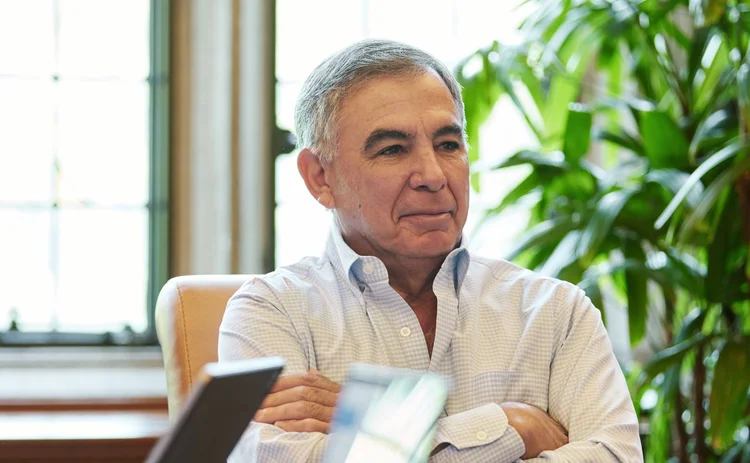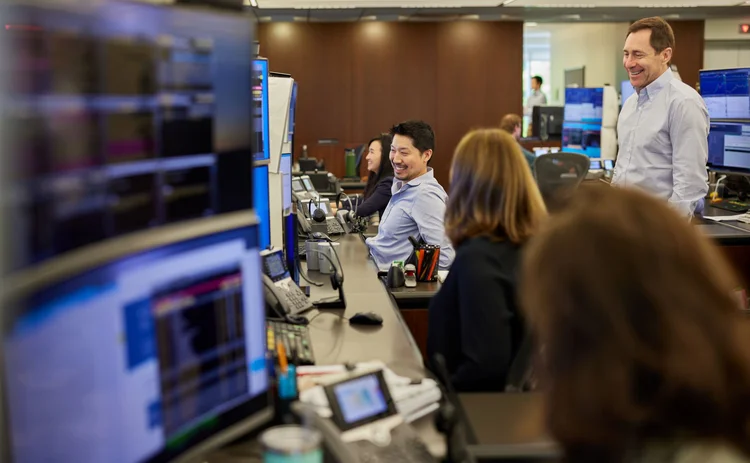
Quant investment firm of the year: Graham Capital Management
Risk Awards 2024: In a year of reversals, a mix of quant and discretionary approaches keeps firm among top macro performers

As much as 2022 was the ideal year to be a quant investor, 2023 has been a difficult time for many systematic strategies.
Markets have reversed and re-reversed – denying quant models the kinds of steady patterns they thrive on.
Trend following, the most widely used strategy among macro quants, has lost money. Societe Generale’s trend-following index is down more than 3.5% year-to-date at the time of writing.
Quant firms, then, have had to rely more on strategies that trade in other ways – strategies that capitalise on mean reversion and carry, or that select investments based on fundamentals.
At Graham Capital Management, those strategies came good.
“Markets came into the year thinking there would be a big slowdown in the economy,” says Pablo Calderini, president and chief investment officer at Graham Capital Management. “Then we had massive payroll numbers in February that set up the idea that maybe the US economy was still growing a lot. Then you had the Silicon Valley Bank collapse in March.”

Graham Capital’s Quant Macro fund, though – which combines several of its core models – was up 8%, net of fees, for the year to October. Its Proprietary Matrix fund, which allocates approximately 50/50 between the firm’s quant and discretionary investing units, was up 8.7%.
Hedge Fund Research’s index for macro quant hedge funds is down two thirds of a percent year-to-date. The HFR composite index was up just 2.2% at the time of writing.
Graham Capital’s trend-following fund, which delivered 31% net returns in 2022, has also remained in positive territory – up roughly 3% for the year to October 2023.
When March’s collapse of Silicon Valley Bank caused a rally in fixed income that wrong-footed many quant firms, Graham’s mean-reversion models had determined that the downtrend in bonds was over-extended and were generating long fixed income signals.
And the firm’s fundamental macro strategy boosted a long position in crude oil in October, within two-to-three days of the latest hostilities in Gaza, says Thomas Feng, Graham’s quant CIO.
This kind of robust performance in a tough year follows an established theme. The hedge fund has been among the top performers in quant macro “pretty much every year”, says a client – and adds that this is unusual in a field where the standout managers tend to change often.
Conviction
Graham’s models generate directional forecasts, which the firm combines with signal conviction scores for each model and market during portfolio optimisation. Different signals can “take the baton” in different market environments, says Calderini.

The firm’s carry strategies, for example, crimp their bets if volatility spikes. As Feng explains: “We know carry only works when you have stable prices.”
In weighting the influence of different models, Graham Capital is agnostic about recent performance, allowing strategies with strong conviction to dominate others, even when the high-conviction strategy has experienced recent losses.
But strategies that hold correlated positions – and may be exposed to crowded trades – receive lower allocations, says Feng.
In addition to the offset from mean reversion in March, the firm’s fundamental macro model took short positions in June and July, for example, as the dollar slid sharply.
Slow, slow, quick!
Graham Capital’s mean reversion models are built to move slowly, then quickly – to check first that markets are reverting as expected – before scaling rapidly into positions when price movements confirm the model’s view, says Feng.
It’s an approach designed to avoid the so-called value trap, where the model might increase holdings in an asset that is sliding away from its long-term average for good reason.
The firm’s macro fundamental strategy, meanwhile, exists to deal with the kind of “conditioning behaviour” in markets that can upend more conventional models, says Feng. These are times when bad news turns out to be good news – or good news bad.
In October, for instance, non-farm payroll numbers in the US were weaker than expected, but equities rallied. Markets took the view that further rate hikes had become less likely.
Our quant engineers are able to see and understand how discretionary portfolio managers make decisions and look at markets and decipher data
Brian Douglas, Graham
Feng, who became CIO for quant strategies in August, following Edward Tricker’s retirement, built the first version of the fundamental macro model when he joined Graham in 2009.
The model ingests close to 500 types of market data, including sentiment data, and reacts one-to-two weeks faster than models that rely only on traditional macroeconomic inputs, says Feng.
The model is not engaged in so-called unsupervised learning – it’s no ‘black box’, autonomously hunting for tradeable patterns in markets. Instead, it chooses from an array of different pre-formed, economic theory-based quant signals that best explain market moves at a given point in time.
The latest iteration also employs pattern recognition to search for past episodes that match current conditions – and favours models that performed well at these times.
When war broke out in Ukraine in 2022, Graham was short wheat. The fundamental macro model, alongside the firm’s carry models, picked up on changing news sentiment and backwardation in the futures curve, triggering a switch to a significant long position within “a few days”, says Feng.
This October’s move to go long oil was driven by news sentiment – but as inventory data started to indicate that an oil shortage was unlikely, the model tapered the position.
The right blend
Constructing the kind of machine that deploys the behaviour of discretionary traders comes naturally to an investment firm that has combined quant and discretionary approaches since its infancy. Blending the two styles “is something that is really dear to us”, says Calderini.
The firm was founded as a systematic manager in 1994 by Ken Tropin, who four years later set up a discretionary unit. In its Proprietary Matrix fund, Graham has been mixing quant and discretionary investing since 1999.
“They are two distinct styles of macro trading, trading many of the same markets but doing it differently, with different ways of scaling in and out of positions, different time horizons, and so on,” says Brian Douglas, Graham’s chief executive. Each can learn from the other, he says.
Just knowing which pieces of data are in fact relevant – that’s a big help
Thomas Feng, Graham
“Our quant engineers are able to see and understand how discretionary portfolio managers make decisions and look at markets and decipher data – and they’re able to take that into consideration when they build models,” says Douglas. “Our discretionary managers are able to understand from the systematic engineers how they process data, and how they think about execution and how quantitative models use certain data to make trading decisions.”
Feng confirms that watching discretionary portfolio managers helps sift the masses of information now available to quants. “Just knowing which pieces of data are in fact relevant – that’s a big help,” he says.
Equally, the quant team runs a model that replicates the behaviour of the average trend follower, producing a report for the discretionary traders about how that investor group is likely to act at different times.
Positive outlook
Right now, Calderini sees plenty of opportunity for quant macro.
For more than a decade, until 2022, loose monetary policy made for “more challenging times to trade” for macro strategies, he says. “Any pattern that emerged was quickly killed by the central banks.”
But that changed in 2022 with the emergence of inflation, unleashing a cascade of patterns in markets that produced a fertile environment for macro investors – and a banner year for quants.
“At the outset of 2022, you knew that rates were about 400 basis points below equilibrium,” says Calderini. “You knew that rates would have to go up.”
“That’s a trade: short fixed income. You also know that when that happens the yield curve becomes flatter. That’s another trade,” he continues. “You know that usually the Federal Reserve leads the charge globally, so the dollar gets stronger first. And then real rates go up, which means that gold does badly, and equities do badly and so on.”
This year may have been characterised by reversals, but Calderini thinks the countervailing trends to 2022 may soon assert themselves. “If we go into a recession, maybe that same pattern emerges in reverse. There’s a greater opportunity to buy fixed income. The yield curve will be steeper. The dollar will get weaker, and so on.”
He is also realistic. “I don’t expect every year to be like 2022,” he says. “But I do expect future years to be better than they were from 2010 to 2020.”
Only users who have a paid subscription or are part of a corporate subscription are able to print or copy content.
To access these options, along with all other subscription benefits, please contact info@risk.net or view our subscription options here: http://subscriptions.risk.net/subscribe
You are currently unable to print this content. Please contact info@risk.net to find out more.
You are currently unable to copy this content. Please contact info@risk.net to find out more.
Copyright Infopro Digital Limited. All rights reserved.
You may share this content using our article tools. Printing this content is for the sole use of the Authorised User (named subscriber), as outlined in our terms and conditions - https://www.infopro-insight.com/terms-conditions/insight-subscriptions/
If you would like to purchase additional rights please email info@risk.net
Copyright Infopro Digital Limited. All rights reserved.
You may share this content using our article tools. Copying this content is for the sole use of the Authorised User (named subscriber), as outlined in our terms and conditions - https://www.infopro-insight.com/terms-conditions/insight-subscriptions/
If you would like to purchase additional rights please email info@risk.net
More on Awards
Joining the dots: banks leverage tech advancements for the future of regulatory reporting
The continued evolution of regulatory frameworks is creating mounting challenges for capital markets firms in achieving comprehensive and cost-effectiveawa compliance reporting. Regnology discusses how firms are starting to use a synthesis of emerging…
Markets Technology Awards 2024 winners' review
Vendors spy opportunity in demystifying and democratising – opening up markets and methods to new users
Derivatives house of the year: JP Morgan
Risk Awards 2024: Response to regional banking crisis went far beyond First Republic
Risk Awards 2024: The winners
JP Morgan wins derivatives house, lifetime award for El Karoui, Barclays wins rates
Best product for capital markets: Murex
Asia Risk Awards 2023
Technology vendor of the year: Murex
Asia Risk Awards 2023
Best structured products support system: Murex
Asia Risk Awards 2023
Energy Risk Asia Awards 2023: the winners
Winning firms demonstrate resiliency and robust risk management amid testing times
Most read
- Revealed: the three EU banks applying for IMA approval
- Industry urges focus on initial margin instead of intraday VM
- Top 10 operational risks for 2024







